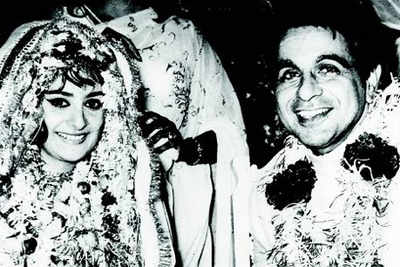- News
- entertainment
- hindi
- bollywood
- Dilip Kumar and Saira Banu's love story
Trending
This story is from September 30, 2013
Dilip Kumar and Saira Banu's love story
When the daughter of actress Naseem Banu-- the famed actress of the sixties-- went to watch the premiere of 'Mughal-e-Azam' (1960), no one knew what fate had in store for this 16-year-old shy girl and Sehzada Salim aka Dilip Kumar

When the daughter of actress Naseem Banu-- the famed actress of the sixties-- went to watch the premiere of 'Mughal-e-Azam' (1960), no one knew what fate had in store for this 16-year-old shy girl and Sehzada Salim aka Dilip Kumar. The actor who debuted in 1944 with 'Jwar Bhata' was at that time at the helm of his career. But on the personal front, his life was in shambles as his relationship with Madhubala had just ended.However, this is not the story of Madhubala, but of the teenager and her heartthrob, Dilip Kumar.
Saira Banu had to return brokenhearted that day, as the actor didn’t make it to the premiere. A year later, she made her debut in the film industry with 'Junglee' opposite Shammi Kapoor and there was no looking back. She went on to star opposite the leading men of her time, Biswajeet, Joy Mukherjee, Rajendra Kumar and of course Dilip Kumar. However, it was the much-married Rajendra Kumar the young actress lost her heart to. Their love was doomed from the beginning because of ‘Jubilee’ Kumar’s marital status.
And it was Naseem who played cupid between Saira and her childhood crush Dilip. Rumour has it that Naseem wanted Dilip to talk Saira out of her relationship with Rajendra and eventually the ‘Tragedy King’ fell in love with his Sagina Mahato co-star. He proposed and it was an offer she couldn’t refuse. And the two got married on October 11,1966. He was 44 and she was barely 22. Many eyebrows were raised and people were quick to forecast a failed marriage. How-ever, 47 years and the two have stuck by each other through thick and thin. And when the veteran actor was recently taken ill, Saira stood by him like a rock.
Saira Banu had to return brokenhearted that day, as the actor didn’t make it to the premiere. A year later, she made her debut in the film industry with 'Junglee' opposite Shammi Kapoor and there was no looking back. She went on to star opposite the leading men of her time, Biswajeet, Joy Mukherjee, Rajendra Kumar and of course Dilip Kumar. However, it was the much-married Rajendra Kumar the young actress lost her heart to. Their love was doomed from the beginning because of ‘Jubilee’ Kumar’s marital status.
And it was Naseem who played cupid between Saira and her childhood crush Dilip. Rumour has it that Naseem wanted Dilip to talk Saira out of her relationship with Rajendra and eventually the ‘Tragedy King’ fell in love with his Sagina Mahato co-star. He proposed and it was an offer she couldn’t refuse. And the two got married on October 11,1966. He was 44 and she was barely 22. Many eyebrows were raised and people were quick to forecast a failed marriage. How-ever, 47 years and the two have stuck by each other through thick and thin. And when the veteran actor was recently taken ill, Saira stood by him like a rock.
End of Article
FOLLOW US ON SOCIAL MEDIA









